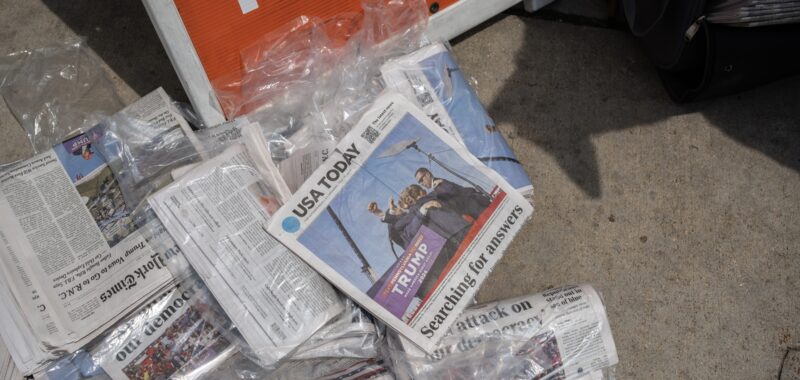Corey Comperatore was seated on the bleachers behind the stage at the Trump campaign rally in Butler, Pennsylvania, last Saturday when a gunman opened fire from the roof of a nearby building. The former president was spared, suffering a minor ear injury, but 50-year-old Comperatore, a firefighter, was shot in the head as he dove to shield his family and succumbed at the scene. Two other people were critically injured before suspected shooter Thomas Matthew Crooks was killed by Secret Service agents.
It was just another day in the United States, where the catastrophically lethal AR-15-style rifle used in the attack can be legally purchased by civilians. But the immediate fascination with the photographs that emerged of Trump in the aftermath of the shooting, raising his fist in the air against the backdrop of an American flag in images widely characterized as “iconic,” distorted the collective understanding of this moment as exceptional.
The photos of the minutes after Comperatore was shot are comparatively few and unremarkable. A series captured by Agence France-Presse (AFP) appears to depict state troopers in gray uniforms dragging a body away from the bleachers, hoisting the cadaver by the legs of his jeans and a limp bloodied hand, though Comperatore is not officially identified in the captions. There is no billowing star-spangled banner or expertly cropped patch of blue sky; the images have neither the compositional flair nor the depth of field or the gravitas of those portraying Trump, taken by photographers for Reuters, AP, and the New York Times.
I am not, of course, suggesting that photojournalists are at fault for doing their job, or that they are complicit in the exhausting romanticization of Trump’s survival by both the right and the left. But the very making of these photographs, and the frenzied, fanatic responses to them, tell us a lot about who is left out of the frame. The most common victims of gun crimes are not high-profile politicians but everyday people — approximately 326 each day in the United States, about a third of whom are killed. In the compulsive analysis of Trump’s image, in even the most well-meaning efforts to contend with its propagandistic dangers, we risk overlooking the mundanity of gun violence and its less mediagenic casualties.
No one, and certainly not progressives, intentionally seeks to glorify Trump’s image. Yet online and in legacy media, the commentators can’t help themselves, serving up empty disclaimers about the pitfalls of comparing documents of violence to art historical masterpieces before falling right into their own trap. Meanwhile, Trump’s raised-fist photograph graces the cover of TIME Magazine, where pictures go to become fixed representations of A Historic Moment while everything around them fades into the distance.
The dialogue focused on Trump’s artfulness in seizing on a golden press opportunity is also misguided and strangely laudatory. The reality is that there were many professional photojournalists at the rally, and they were likely training their lenses on or near the stage. Trump wasn’t seriously injured, so he was able to get back on his feet relatively quickly and make a gesture of defiance while still in the eye of cameras shooting 30 frames per second. Comperatore was not so lucky, nor were many photographers looking in his direction when he was caught in the line of fire in a scene of chaos that witnesses and bystanders described as “terrifying.” Even more puzzling — and revelatory — is the disproportionate attention paid to a photograph that appears to show the path of the bullet that grazed Trump’s ear, taken by NYT staffer Doug Mills. The interest that this faint trail of a projectile in flight has elicited reminds me of the scene in this year’s oddly apolitical A24 film Civil War (2024) in which Joel (Wagner Moura), an adrenaline-addicted war journalist, says that the sound of nearby gunfire turns him on — a juvenile trope that equates firearms with masculinity without genuinely critiquing either.
In his landmark book What Do Pictures Want? (2006), theorist WJT Mitchell proposed assigning an intentionality to images, a sort of philosophical exercise to investigate the mechanics of visual culture’s impact on society. If we were to ask the pictures of Trump with a bloodied ear at the rally what they want, the answer would be obvious: to be the center of attention, to be printed and reprinted, to signal the moment of Trump’s inevitable martyrdom. We still have time to stop them in their tracks, and to shift our gaze to what isn’t being represented.

